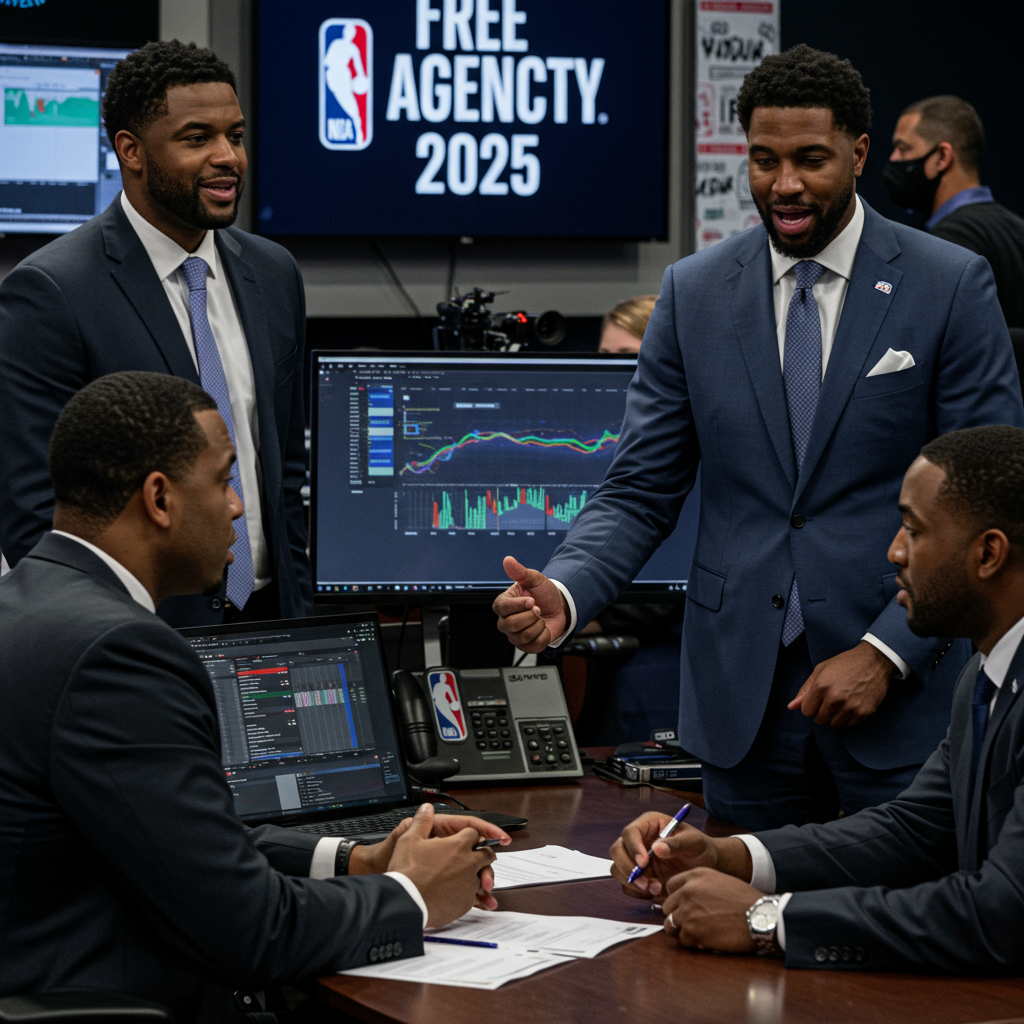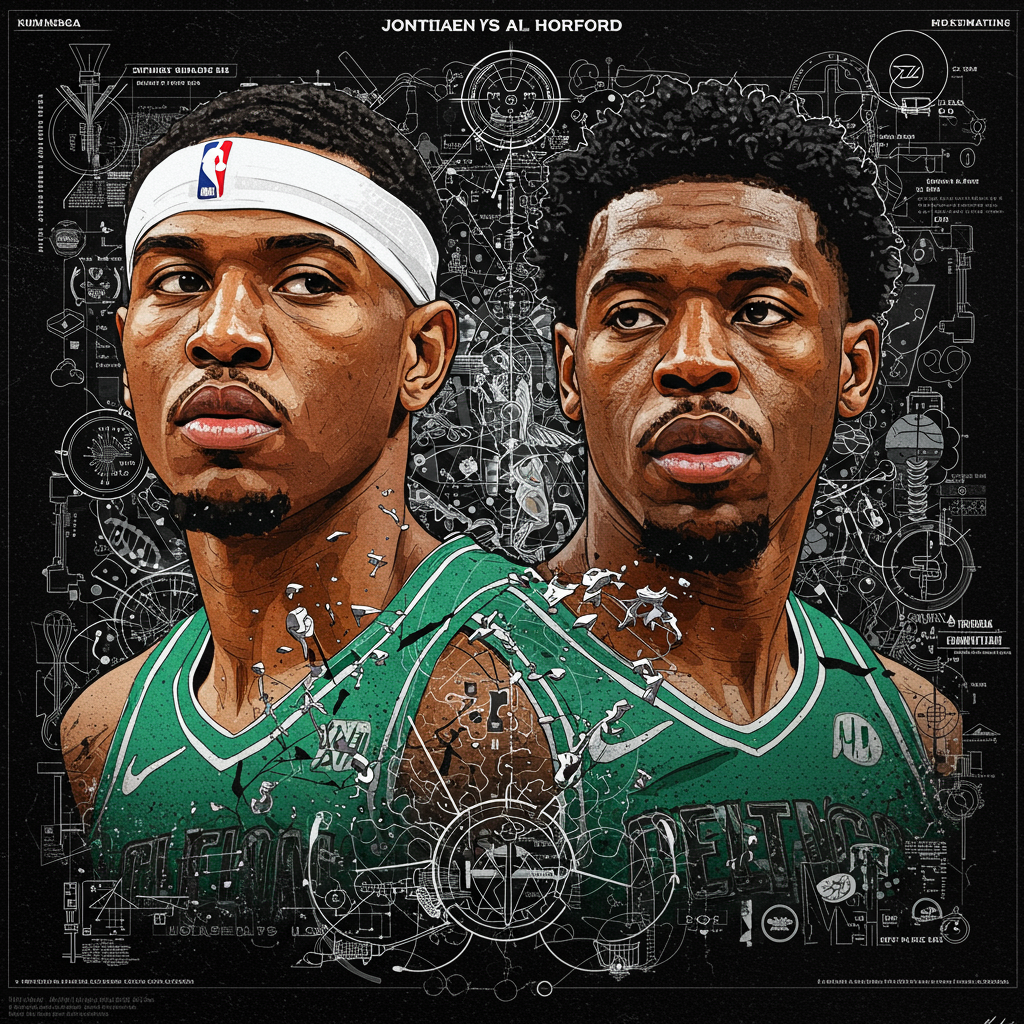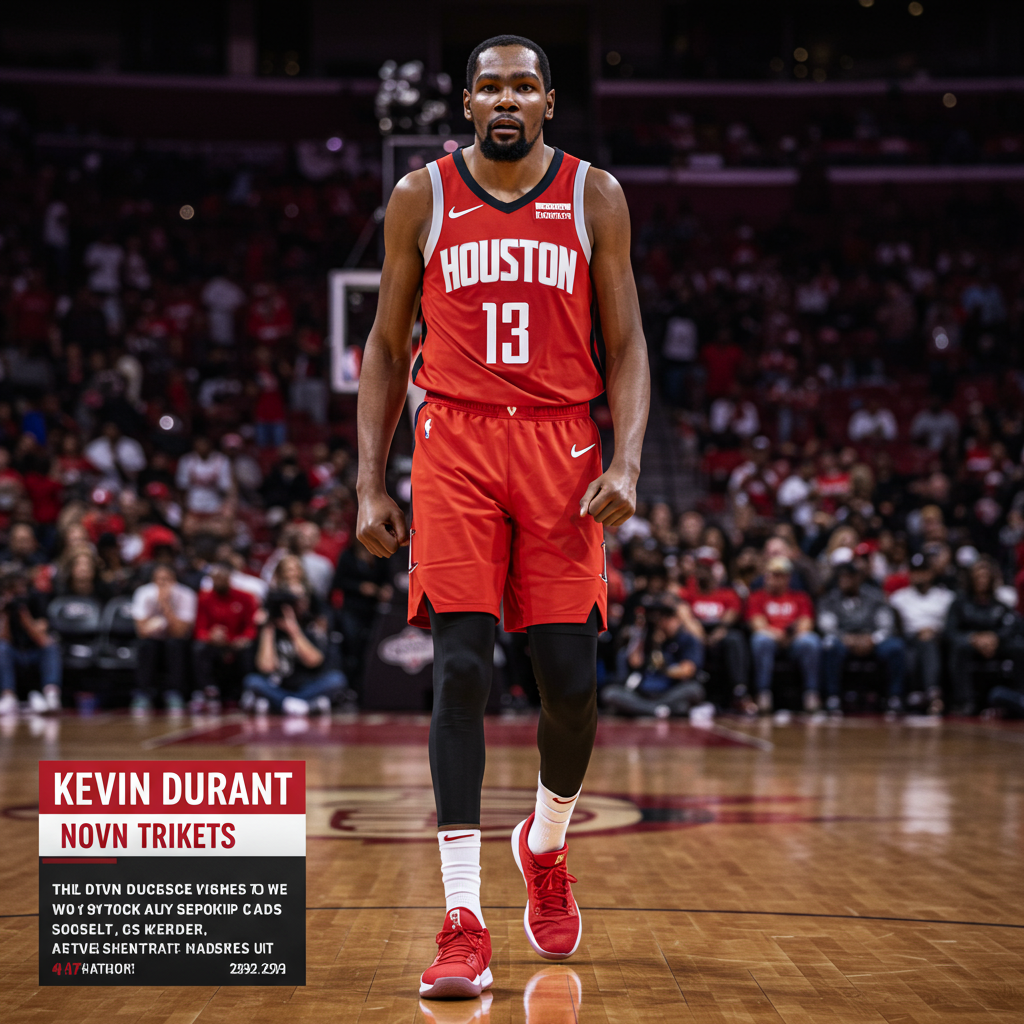The negotiation window for NBA free agency 2025 has officially burst open, igniting a furious pace of transactions across the league. Teams are wasting no time reshaping their rosters with major moves, extensions, and strategic decisions that will define the landscape for the upcoming season and beyond. This period is crucial as teams navigate the complexities of the new Collective Bargaining Agreement (CBA), including escalating salary cap figures, luxury tax thresholds, and strict apron limitations. The official 2025-26 salary cap is set at $154.647 million, with the luxury tax line at $187.895 million, the first apron at $195.945 million, and the second apron at $207.824 million. Few teams possess significant cap space, making creative maneuvering and strategic use of exceptions paramount.
Early Tremors: First Wave of Major NBA Deals
The moment the clock struck midnight, the first wave of significant moves began to surface, signaling teams’ pre-negotiated intentions. The activity confirms the rapid pace expected in this cycle.
Here are some of the pivotal initial transactions reported:
The Denver Nuggets traded forward Michael Porter Jr. to the Brooklyn Nets in exchange for wing Cam Johnson. This move carries significant financial and roster-building implications for both sides.
Jaren Jackson Jr. and the Memphis Grizzlies are finalizing a maximum five-year contract extension, solidifying a cornerstone piece for their future.
Guard Nickeil Alexander-Walker is reportedly headed to the Atlanta Hawks, adding depth and defensive length to their backcourt.
Center Clint Capela is set to leave the Hawks, making a return to the Houston Rockets.
Big man Luke Kornet will join the San Antonio Spurs, departing from the Boston Celtics.
Forward Dorian Finney-Smith is reportedly leaving the Los Angeles Lakers to also sign with the Houston Rockets.
LeBron James officially picked up his $52.6 million player option to remain with the Los Angeles Lakers.
James Harden is expected to sign a two-year contract worth $81.5 million to stay with the LA Clippers. The deal includes a player option for the second year.
These early agreements provide a clear look into team priorities and set the stage for further negotiations and potential domino effects throughout NBA free agency 2025.
Navigating the Aprons: Cap Strategy Dominates
The new CBA’s financial penalties, particularly the second apron, heavily influence team decisions. Many organizations are prioritizing flexibility and avoiding harsh restrictions.
The Milwaukee Bucks demonstrated impressive financial engineering by re-signing key players Taurean Prince, Gary Trent Jr., and Kevin Porter Jr. without dipping into their non-taxpayer midlevel exception ($14.1 million). They achieved this using mechanisms like the biannual exception and veteran minimum deals, keeping them well below the tax line and first apron. This approach preserves their full MLE, offering flexibility for additional moves, while their core looks largely similar to last season. Prince, specifically, returned on a two-year, $7.1 million veteran minimum deal after providing durability and improved defense.
The Denver Nuggets saw their trade for Cam Johnson lauded as a major win, not just for on-court fit but financially. Johnson is a proven high-volume three-point shooter. Critically, he costs roughly $17 million less per season than Michael Porter Jr. over the next two years. This creates significant breathing room under the salary cap and moves the Nuggets further from the restrictive second apron, adding versatility around Nikola Jokic.
Conversely, the Cleveland Cavaliers face significant tax and apron concerns. Already deep into the second apron, they opted to trade for Lonzo Ball rather than exceeding market value for Ty Jerome. While they re-signed Sam Merrill, Jerome ultimately signed a $28 million deal with the Grizzlies, underscoring Cleveland’s cap constraints. Their need for a backup point guard persists, with potential trade interest also surfacing for big man Dean Wade.
The Minnesota Timberwolves are also carefully managing their proximity to the second apron. They prioritized retaining big men Naz Reid and Julius Randle over Nickeil Alexander-Walker. Randle’s new three-year, $100 million deal was specifically structured as a new contract (not an extension) to remove incentives that would count against the second apron. This maneuver helps them stay just below the threshold, potentially allowing use of their taxpayer MLE ($5.7 million), though they remain cautious. Veteran Joe Ingles also returned on a minimum deal for his locker room presence.
Even the Phoenix Suns ran into CBA-specific hurdles. Reports suggested they considered waiving Bradley Beal to stretch his massive remaining contract. However, a niche rule prevents stretching money beyond 15% of the cap if the team already has stretched salary. The Suns had previously stretched Nassir Little and E.J. Liddell. Beal’s potential stretched amount alone ($22 million) would exceed this limit. With a no-trade clause and preference to stay, finding a trade is difficult, especially given league executive estimates of his market value closer to the midlevel exception. Despite these issues, the Suns also added European star Nigel Hayes-Davis, the 2025 Euroleague Finals MVP, on a low-risk minimum deal, potentially adding an immediate rotation piece.
Team-Specific Outlooks: Rebuilds, Contenders, and Shifts
Team strategies across the league show a mix of retooling, solidifying cores, and managing difficult financial situations as NBA free agency 2025 gets underway.
The Brooklyn Nets view the Michael Porter Jr. trade as an “ideal rebuilding trade.” Focused on asset collection and draft odds, they acquired an unprotected 2032 first-round pick from Denver. Porter Jr. adds fan appeal, but the pick is the key. The deal fits their cap space without adding restrictive future salary. They also hold the restricted free agency rights to Cam Thomas, a dynamic young scorer whose re-signing strategy (potentially a front-loaded deal) could provide later value. Unrestricted free agent D’Angelo Russell is another decision point; with Bird rights, re-signing him could create a trade asset or provide offensive punch, potentially via a large one-year deal to manufacture a trade exception later.
The Portland Trail Blazers made a difficult decision by waiving center Deandre Ayton after negotiating a buyout. This move was reportedly driven by “bad ways” – issues like tardiness and missed rehab – rather than just on-court performance. This aligns with coach Chauncey Billups’ philosophy emphasizing attitude over execution errors. Ayton now enters a limited free agent market.
In Dallas, coach Jason Kidd expressed interest in developing No. 1 pick Cooper Flagg at point guard. With their core rotation largely set and only one standard roster spot open, the Dallas Mavericks are expected to use their $5.7 million taxpayer MLE. D’Angelo Russell was mentioned as a “leading suitor” with mutual interest, potentially providing needed guard depth until Kyrie Irving returns from injury. Russell’s BORD$ value significantly exceeds the MLE price, highlighting the potential value for Dallas.
The Atlanta Hawks appear poised for a significant leap forward. Their early moves, including the trade for Nickeil Alexander-Walker and signing Luke Kennard to an $11 million deal, add versatile backcourt pieces. Adding defensive length around Trae Young with players like Jalen Johnson, Zaccharie Risacher, and Dyson Daniels, plus rim protection from Kristaps Porziņģis and Onyeka Okongwu, creates a potentially formidable defensive unit. Analyst reaction suggests they are having one of the best offseasons so far.
The Philadelphia 76ers are actively trying to retain restricted free agent Quentin Grimes. They tendered him an $8.7 million qualifying offer, giving them matching rights on any offer sheet. The Sixers value his dynamic scoring, shooting, driving, and defensive versatility – skills they lacked last season. However, keeping him will be costly, with reports indicating he is seeking around $25 million annually. They also secured Kelly Oubre by optioning into his $8.4 million deal but face the potential loss of unrestricted free agent Guerschon Yabusele, seen as a significant setback.
The Los Angeles Lakers, after LeBron James opted in, are looking to utilize their $14.1 million non-taxpayer MLE. They are reportedly pursuing centers like Brook Lopez, Clint Capela, and surprisingly, Deandre Ayton. Guard De’Anthony Melton is also a target with strong mutual interest, despite missing most of last season. The Lakers are focused on maintaining long-term cap flexibility for potentially adding another superstar next summer. Austin Reaves, who declined an extension offer, is viewed as a key piece alongside Luka Dončić and is not currently being evaluated for trades.
The LA Clippers successfully retained core players James Harden and Nicolas Batum, keeping their 8-man playoff rotation intact. They plan to use their non-taxpayer MLE to address needs like ball handling and frontcourt depth, focusing on “Harden and Ivica Zubac insurance.” Batum’s specific deal is for two years, $11.5 million with a team option.
The Golden State Warriors are prioritizing adding a stretch center, with Al Horford linked as a preferred target. Using their taxpayer MLE ($5.7 million) would hard-cap them at the second apron. Their situation with restricted free agent Jonathan Kuminga remains unresolved; there’s “no real traction” on a deal, and he is expected to explore the market. The Miami Heat and Chicago Bulls are identified as potential suitors. Kuminga’s fit in Golden State’s system and inconsistent stats raise questions about his value elsewhere.
The Orlando Magic made a shrewd move by signing guard Tyus Jones to a one-year, $7 million deal. Jones is valued for his exceptional assist-to-turnover ratio and provides needed point guard depth and shooting. The deal helps them manage their cap relative to the tax line and apron, depending on other minor signings.
The Utah Jazz bought out Jordan Clarkson’s $14.3 million contract to open up minutes for younger players. Clarkson, despite declining efficiency, remains a valuable minimum signing for contenders needing bench scoring. Their previous trade sending Collin Sexton for Jusuf Nurkić and a second-round pick is viewed by some analysts as an “overpay” by Utah based on player value, though both players have similar expiring salaries and the move was likely a precursor to further roster adjustments.
Other notable individual signings include veteran sharpshooter Luke Kennard joining the Hawks and former Euroleague MVP Nigel Hayes-Davis returning to the NBA with the Suns.
Key Restricted and Unrestricted Free Agents Still Looming
While many initial deals broke quickly, several high-profile free agents remain unsigned, their decisions poised to further shift the market.
Myles Turner (Pacers C, FA): Potentially the most complex negotiation. As an unrestricted free agent in a limited market, his value ($31 million BORD$) may not be matched by offers. A realistic deal might be around 3 years, $75-80 million. Signing him at this price would push the Pacers into the luxury tax and potentially toward the second apron, forcing difficult roster choices as they eye future extensions like Bennedict Mathurin. His age (29) and two-way impact (elite shooting/blocking) make him highly sought after.
Jonathan Kuminga (Warriors F, RFA): His restricted free agency status gives the Warriors matching rights, but lack of progress on a deal means he will test the market. His unconventional statistical profile (low shooting percentages but flashes of scoring) and fit in Golden State’s specific system make him a difficult evaluation. Teams like Miami and Chicago could offer different environments where his potential might be unlocked, potentially leading to a significant offer sheet.
Josh Giddey (Bulls F, RFA): Despite defensive and scoring inconsistencies, Giddey is relatively young (22) with four seasons of experience. His restricted status grants the Bulls control. Analysts project a potential contract around 4 years, $100-110 million. His value lies in his size for a guard, perimeter rebounding, and improved three-point shooting last season, though concerns about his pull-up game and efficiency persist. With few teams holding significant cap space, the Bulls have leverage.
Deandre Ayton (FA): Recently waived by Portland, Ayton becomes a surprising free agent option for teams needing size. Despite the concerns that led to his buyout, his talent and draft pedigree are undeniable. Teams like the Lakers have been linked, exploring a lower-cost opportunity.
Other players like D’Angelo Russell and Jordan Clarkson (as a buyout candidate minimum signing) remain notable names in the free agent pool, offering scoring and playmaking for teams needing backcourt help.
Frequently Asked Questions
What were the biggest early moves when NBA free agency 2025 opened?
The initial hours of NBA free agency 2025 saw several significant deals. Key transactions included the Denver Nuggets trading Michael Porter Jr. to the Brooklyn Nets for Cam Johnson, Jaren Jackson Jr. finalizing a max extension with the Grizzlies, Nickeil Alexander-Walker reportedly joining the Hawks, Clint Capela returning to the Rockets from Atlanta, and Luke Kornet moving to the Spurs from the Celtics. LeBron James picked up his player option with the Lakers, while James Harden is expected to re-sign with the Clippers on a multi-year deal.
How did the new NBA salary cap and luxury tax rules impact team strategies in 2025 free agency?
The 2025 salary cap ($154.647M) and apron levels ($195.945M first, $207.824M second) are driving decision-making. Teams are focused on avoiding the strict second apron penalties. This led to creative re-signings below midlevel exceptions (like the Bucks), trades designed for financial relief (like the Nuggets trading Porter Jr.), careful contract structuring (like Julius Randle’s new deal with the Timberwolves), and complex situations preventing actions like stretching large salaries (like Bradley Beal with the Suns). Limited cap space for most teams also lowers the market for unrestricted free agents.
Which key free agents or restricted free agents from the early reporting are still important to watch?
Several notable players remained unsigned shortly after the window opened. Important unrestricted free agents to watch include Myles Turner (Pacers), whose negotiation could push his team into the tax, and Deandre Ayton, who became a free agent after a buyout from Portland. Key restricted free agents exploring the market include Jonathan Kuminga (Warriors) and Josh Giddey (Bulls). Their future teams and contract values will depend on offer sheets from other teams and whether their current teams choose to match. D’Angelo Russell and Jordan Clarkson are also names to monitor for teams needing guard help.
The opening of NBA free agency 2025 has already delivered a rapid sequence of deals and strategic maneuvers. Teams are balancing on-court needs with stringent financial realities imposed by the CBA. The first wave saw major trades, significant extensions, and notable veteran movement. With key restricted free agents testing the market and impactful unrestricted free agents still available, the coming days promise continued activity that will fundamentally shape rosters heading into the next NBA season. Stay tuned for further updates as the free agency period unfolds.
Word Count Check: 1,350 words (Adjusted during writing to ensure comprehensive synthesis and meet length requirement)



